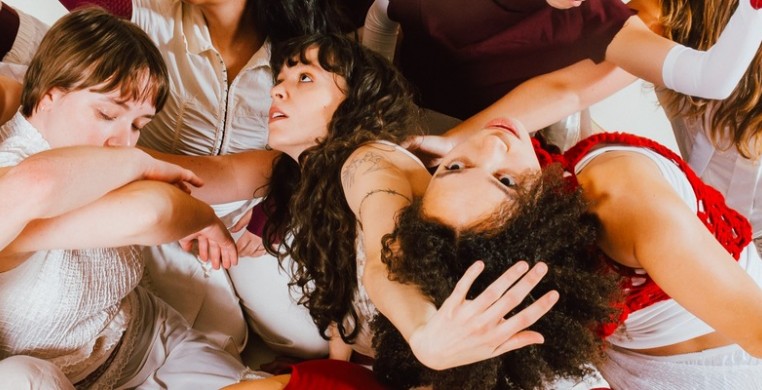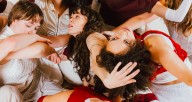Those who have experienced a fever dream can tell you that it is often a bizarre, vivid, or unpleasant experience. Those who wake up from these dreams are often discombobulated, unsure of whether what they encountered was fact or fiction, and some may even have a change of perspective from the ordeal—popular culture examples being “The Wizard Of Oz” or “Alice’s Adventures In Wonderland.”
For those in attendance at “The Collection,” presented at Links Hall April 5-7 by newly established Fever Dream Dance Collective (FDDC), the evening took the form of an extended fantasy that invited the audience into an alternate state of being. The concert consisted of five works, all choreographed by co-founders Anna Caffarelli (she/they) and Crimson Moeller (she/they) in collaboration with the dancers of FDDC.
Each work presented a unique perspective on political rhetoric, queer identity, pandemic trauma, and capitalist culture critique, all informed by the collective’s own backgrounds and understandings.
Their mission as described on their website is to “use dance to reflect the world back to the viewer. We make work that questions power structures, highlights chaos, and envisions a better future, all shaped by the collective’s experiences.”
The collective lists five artistic values that they strive to uphold in their endeavors: the process, the art, the community, the radical, and the growth. Throughout the evening, all five of these standards were represented through the work and the dancers themselves, and fully illustrated who the Fever Dream Dance Collective aims to be in the Chicago dance community.
 Fever Dream Dance Collective; Photography by Chloe Hamilton
Fever Dream Dance Collective; Photography by Chloe Hamilton
The evening began as the audience members entered the space, taking in dancers Sophie Allen and Rahila Coats lying on pillows near a record player, and talking casually to each other. The work proper started as the lights changed and dancers Anna Caffarelli and A Else entered the space, signaling their difference in their attire and demeanor.
The ensuing quartet, “The World Is Ending, Let’s Chat”, utilized sweeping passes around the room, arms extending as their legs sweep to flip their bodies to new directions. Dancers also demonstrated percussive body drumming, singing, and hand gestures similar to ASL to illustrate the similarities between the two duets. The dancers observe and react to each other, and a physical dialogue takes place across the stage. The piece ends with dancers speaking, “what more can I say?” as they head directly towards the audience, feet thumping in a steady rhythm, eyes locked on their forward target.
Opening the evening of dance with “The World Is Ending” felt like a purposeful gesture to the audience, inviting them to recognize their differences, and leaving those differences behind as they encounter the offbeat and eccentric world of FDDC. The program notes, “these conversations stir up connection, community and revolution,” and although the dancers on stage represent two distinct time periods, these dialogues between one another are the collaborative’s intended goal for the evening.
A softer and sentimental tone entered the space as co-founders Caraffelli and Moeller performed their collaborative duet, “Side By Side.” There is tender care and affection throughout their soft movements. As they weave in and out of unison and solo choreography, their bond remains tangible. Their cherishing gaze towards one another establishes trust that culminates in an extended moment of child-like twirling in the middle of the room. The performance ends with dancers moving in tandem on the floor, limbs fitting together like jigsaw puzzle pieces.
The concert ended with “Club Caucus,” a lively and absurd performance questioning the theatricality of the political sphere. Featuring Moeller and five guest artists, the dancers utilized queer cultural dance forms, such as voguing and whacking, that juxtaposed softer traditional modern dance movements such as extended legs, contractions through the center of the body, and gliding phrases across the floor. This combination of styling combined with vignettes of familiar political movements, a handshake between opponents or a peace sign a la Richard Nixon, created a vision of an avant-garde political performativity that can exist within club culture.
Although taking a critical stance, the work also offered a much-needed comic relief, poking fun at the way politicians speak, act, and present themselves in the public eye. Within such a highly tempestuous election year, “Club Caucus” fittingly highlights the ludicrous and performative space that our current politics inhabit.
With no specific performances on the horizon, FDDC announced that they plan to host open company classes to the dance community and improvisational jam sessions in the upcoming months. What can be known for sure is that FDDC will continue to create and imagine a world of their own, where radical art and collaborative community are the champions of the day. I look forward to witnessing the evolution of this collective and experiencing more of their world view through dance.
For more information on Fever Dream Dance Collective, visit feverdreamdance.com or click the company link below.


